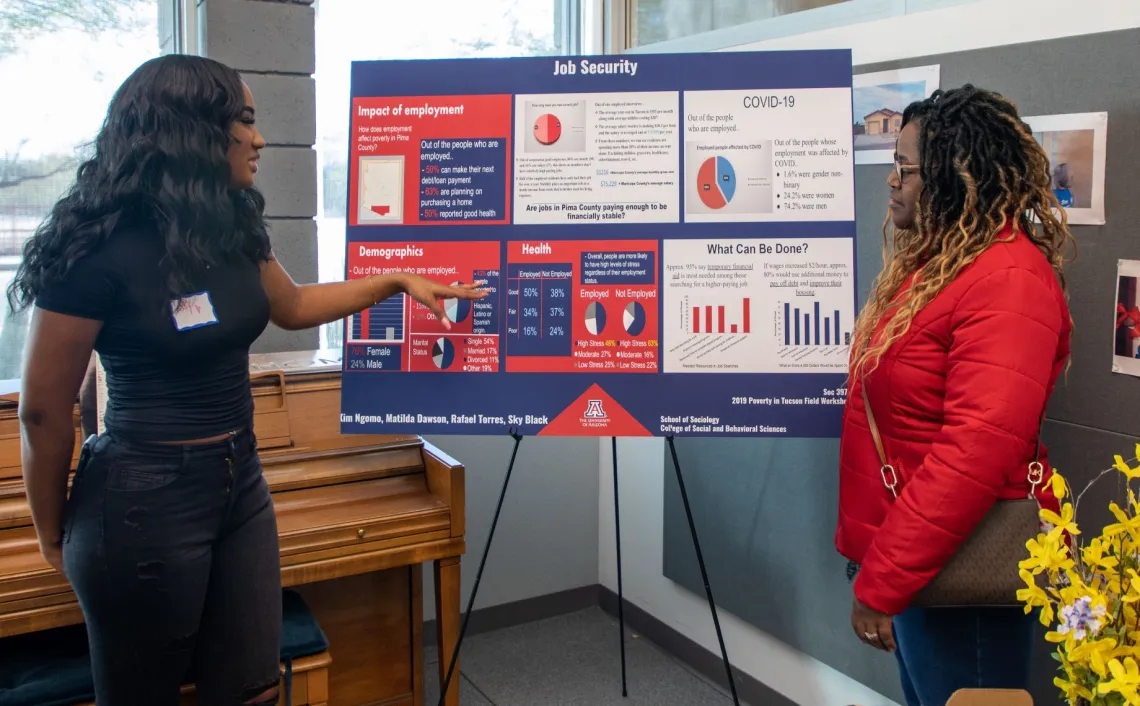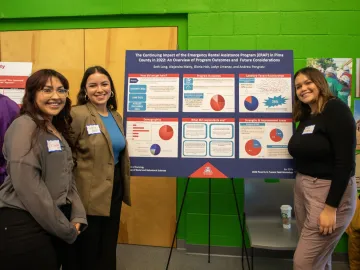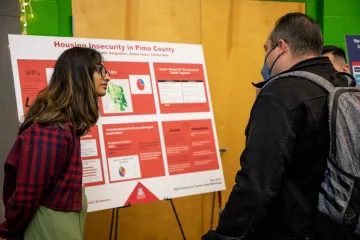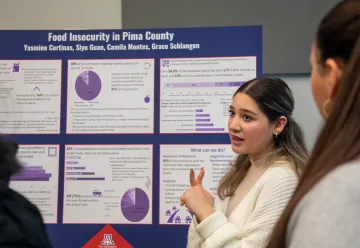Students' poverty project sheds light on needs of Pima County's housing-insecure residents
University of Arizona students surveyed nearly 300 people struggling with housing insecurity and found that rising housing costs and grocery bills were among their top concerns.

Students in the Poverty in Tucson Field Workshop explained findings to community members. Photo by Alicia Raber.
Amid rising inflation, many low-income residents in Pima County are struggling with the cost of housing despite rental assistance received during the pandemic, according to data collected by University of Arizona students.
The students presented their findings to more than 100 community members, city officials and nonprofit organizers at the Poverty in Tucson Field Workshop community forum, held at Habitat for Humanity Tucson on Dec. 13. The forum marked the culmination of the students' semester-long efforts to collect data from low-income households across Pima County.
The annual workshop is a student-powered project offered through the School of Sociology in the College of Social and Behavioral Sciences to help local government and nonprofit organizations better understand the causes and consequences of poverty, which impacts about 20% of households in Tucson. Since 2015, the workshop has partnered with the City of Tucson, Pima County and local nonprofits, including Habitat for Humanity Tucson.

Students examined the impact of the Emergency Rental Assistance Program in Pima County. Photo by Alicia Raber.
This is an important time to examine the ongoing needs of housing-insecure individuals in Pima County, said Brian Mayer, a professor of sociology who directs the Poverty in Tucson Field Workshop.
"Many vulnerable residents in Pima County are finding themselves in a shifting landscape of resources," Mayer said. "As the Emergency Rental Assistance Program funds dry up and costs on housing, utilities and food increases, low-income households are facing challenges in accessing affordable housing, food, child care and utilities."
For this year's workshop, the class surveyed, via Zoom or over the phone, 278 people who applied for emergency rental assistance from Pima County in the past year. These participants, identified as housing insecure, were asked about affordable housing, finances, food insecurity, community resources, job security, mental health and child care.
"This is critical information for us," said Bonnie Bazata, Ending Poverty Now program manager with Pima County Community Services. "With Brian and his class helping us and surveying our clients, it gives us a window into what is happening to some of our most vulnerable families and how they've experienced the program. And that can really help us think about how we shape our programming going forward."
Housing costs remain a top concern
Many housing-insecure residents received unprecedented levels of rental assistance from the federal government during the COVID-19 pandemic. But the moratorium on evictions ended on Aug. 26, 2021. Over 80% of respondents received assistance from the federally funded Emergency Rental Assistance Program, or ERAP, in 2022.

In 2022, rents increased an average of 30% in Pima County. Photo by Alicia Raber.
As students found in speaking with Pima County residents who received ERAP funds, this money allowed people to stay in their homes, catch up on overdue bills and purchase other necessities, such as clothing and food.
Despite receiving 4.5 average months of assistance, only 43% of respondents were confident that they could pay their rent.
In 2022, rents increased an average of 30% in Pima County. Sixty percent of the respondents saw an increase in rent over the last year at an average of $230 per month, and 60% also reported an increase in the price of utilities. Most respondents, 76%, believed that the price of their rent would continue to increase in the future.
The students also found that almost 90% of those surveyed are housing overburdened, which means they are paying over 30% of their income for rent.
"Many of these people were employed, working multiple jobs," said student Vaisha Nair. "Regardless of their situation, most of them were unable to keep up with rent. This is a basic cost, one of the first things we need."
"These are people who got ERAP, so they got funding to stay housed," Mayer said. "But even with that funding, they are still incredibly housing insecure. That program is going away in February, and we're going to run out of money to support people. Absent those funds, people are going to be in a lot of danger, perhaps becoming homeless or having to move, as their rents increase but their wages don't increase."
Mayer added, "People are struggling. We need to have a conversation about what we can do to create more affordable housing to help ease this crisis."
Struggling to 'get by'
When asked if they were able to "get by" with their available household resources each month, most respondents reported that they were scraping by, with 53% of respondents feeling that they had "just enough" and 38% not having enough resources to make ends meet. Over 50% of respondents were living below the federal poverty line.
In the event of an emergency, 44.5% reported that they could not come up with $500 to pay an emergency bill, putting them at risk for ongoing housing insecurity.

Students reported on food insecurity among the respondents. Photo by Alicia Raber.
Almost all respondents, 87%, saw an increase in their grocery bills. To manage food insecurity, 61% of respondents reported skipping meals, 65% reported eating less, 75% reported eating less healthy options and 54% reported going hungry on occasion.
Of those interviewed, 50% reported high or extreme levels of stress.
"People who received ERAP are definitely going through challenges financially, and that can have a huge impact on how you feel, your work and your personal life," said student Annie Wagner. "We recommend providing people who receive these benefits with information about mental health services."
Families with children were slightly less vulnerable, likely due to their access to community resources including the federal government's Supplemental Nutrition Assistant Program, the Arizona Health Care Cost Containment System, child care subsidized by the Arizona Department of Economic Security, and the Special Supplemental Nutrition Program for Women, Infants and Children, known as WIC.
"These resources are particularly important as we see that households with children are more likely to be living below the poverty line than the households interviewed without children," Mayer said.
Hands-on learning for students
The 39 students in the course gained hands-on social science research experience and an enhanced understanding of poverty-related issues.
"The students speak to the people in the community and hear their stories to understand what poverty looks like in Tucson," said Erin Heinz, a postdoctoral researcher in the School of Sociology who co-taught the course with Mayer. "These are our neighbors."
Nair said the class was one of her favorites.
"I was able to get to know more of the demographic of Tucson," she added. "There's so much poverty here, and I think sometimes when you live in the campus bubble, it's really hard to see that."
Student Ariana Bustamante said the course was eye-opening.
"We're about to go out into the big world and graduate college, so it was kind of scary to see how some people had higher-level education and how life can sometimes just take a turn," she said, adding that she was struck by the resilience of the people she spoke to.
"The class was a wonderful opportunity to really talk to people and ask them how they are," said student Vanessa Hernandez. "It felt like I could help the community a little bit."

